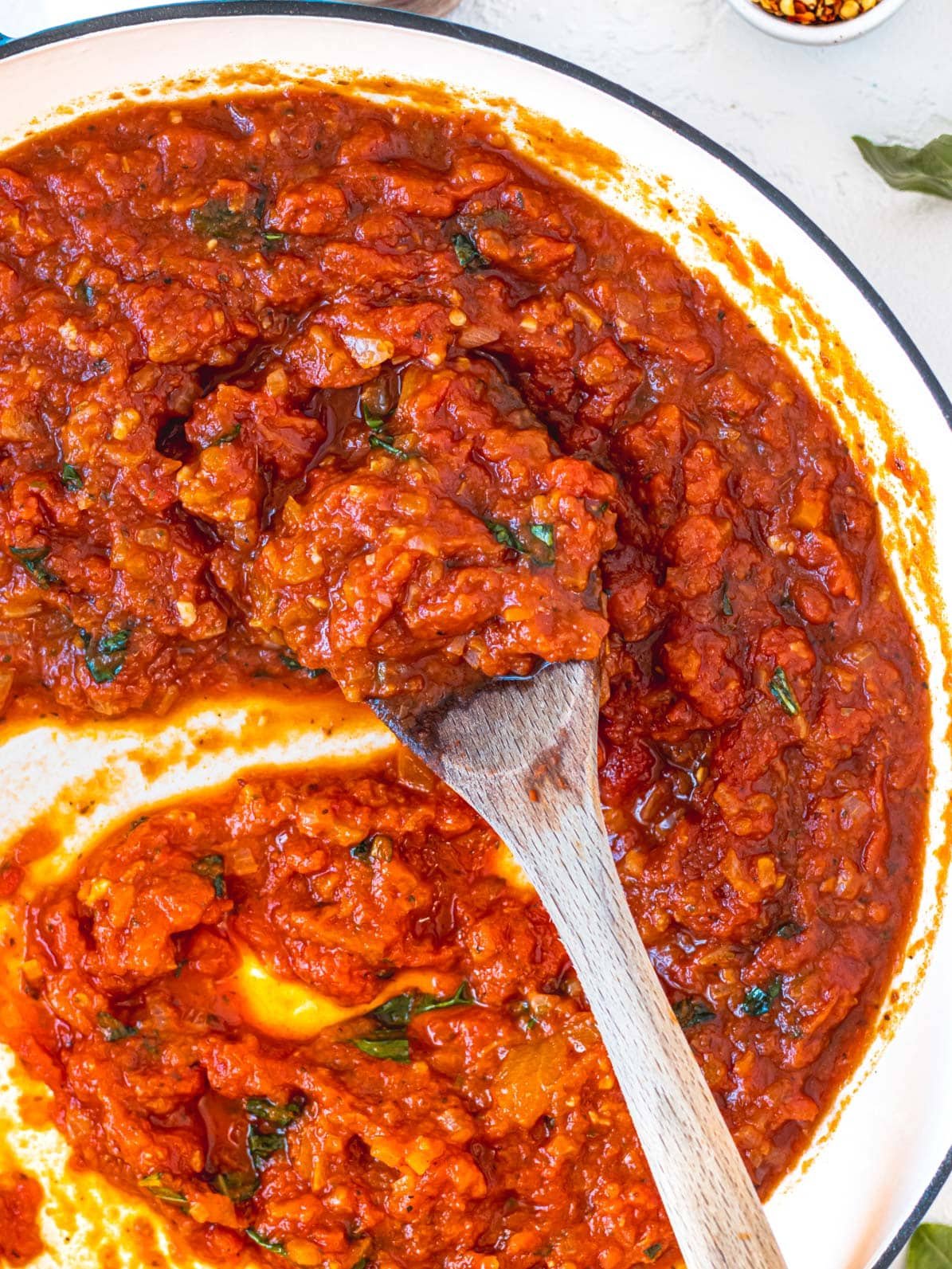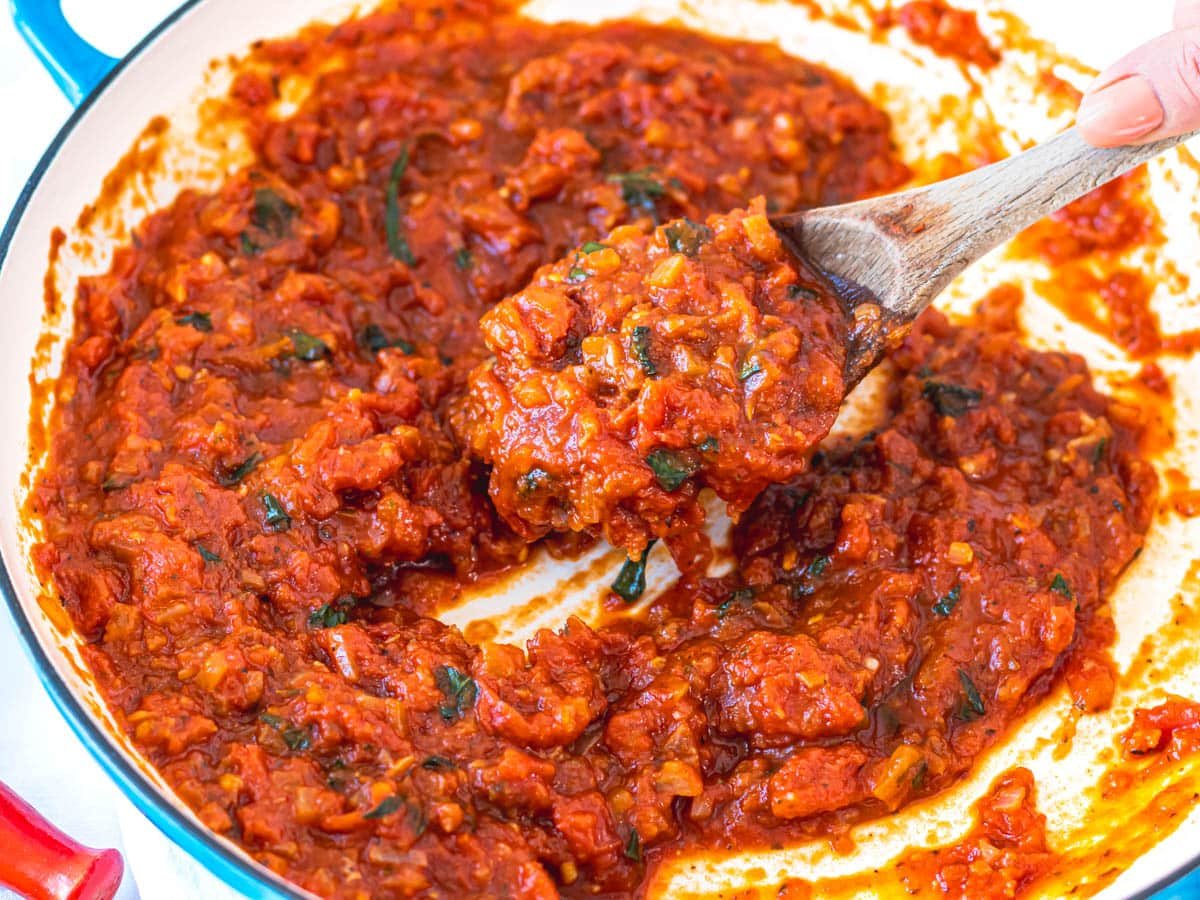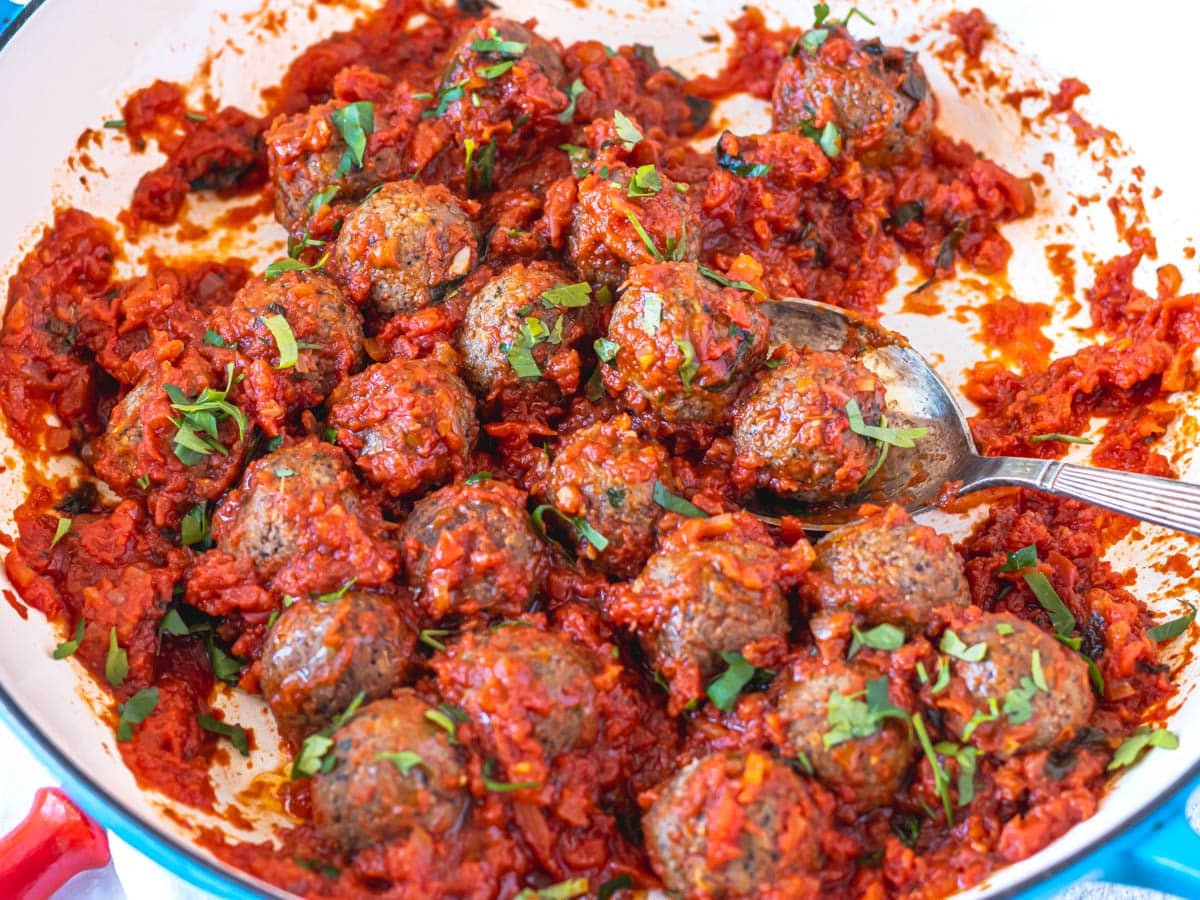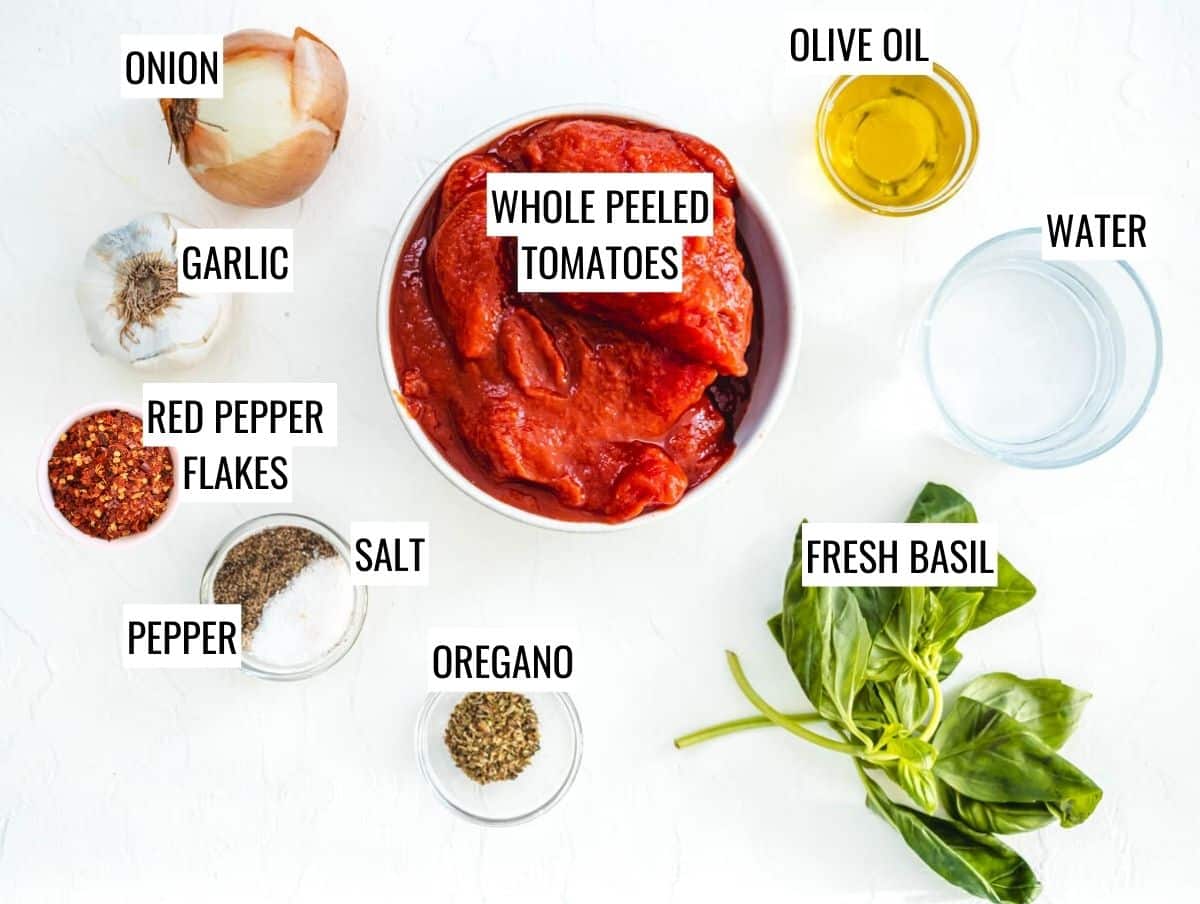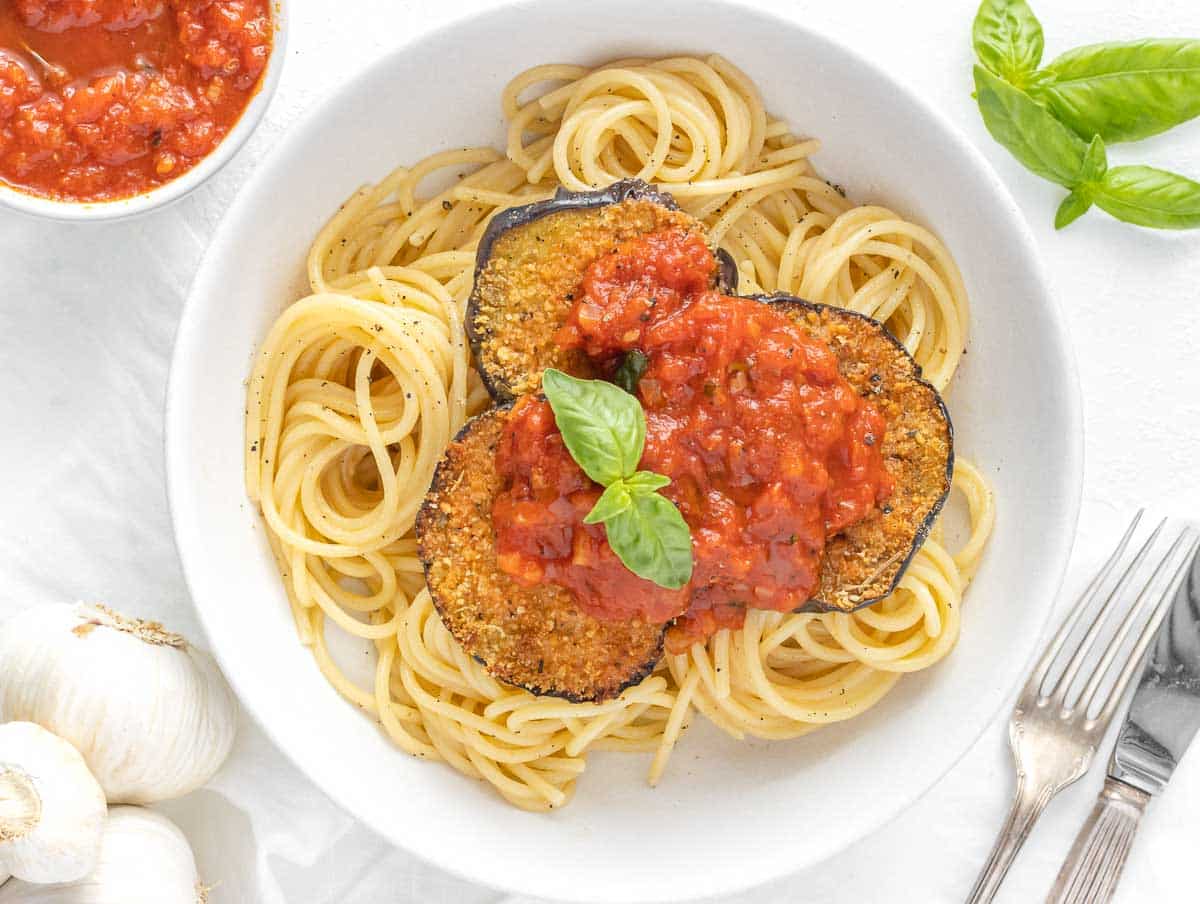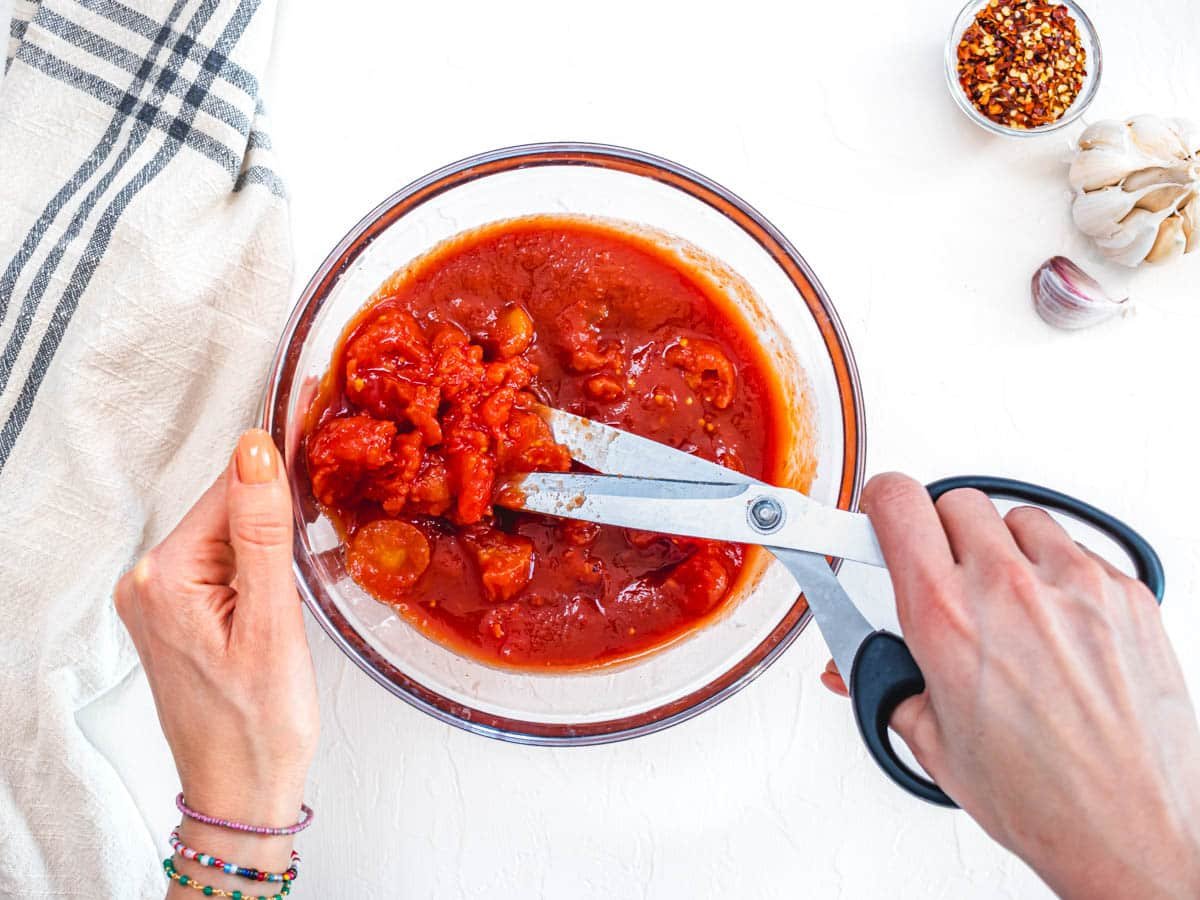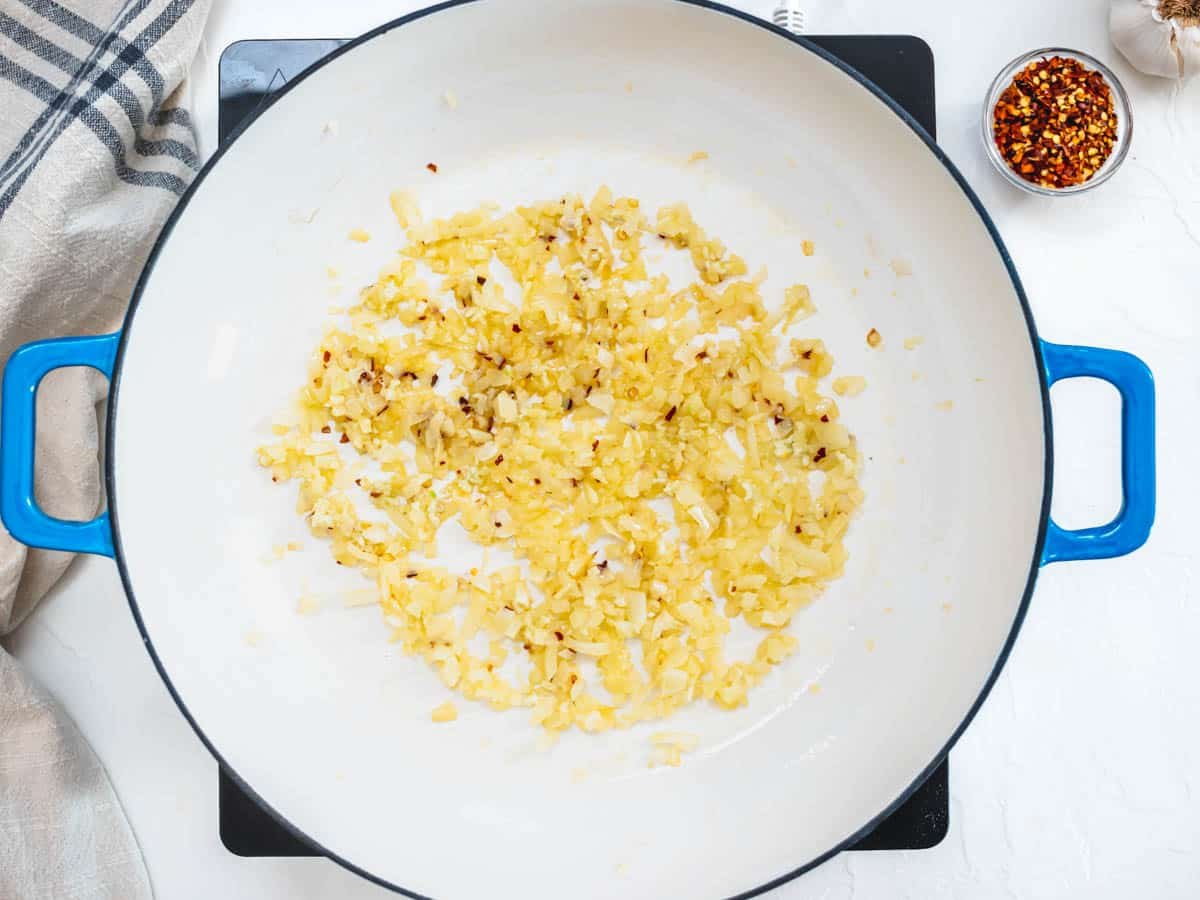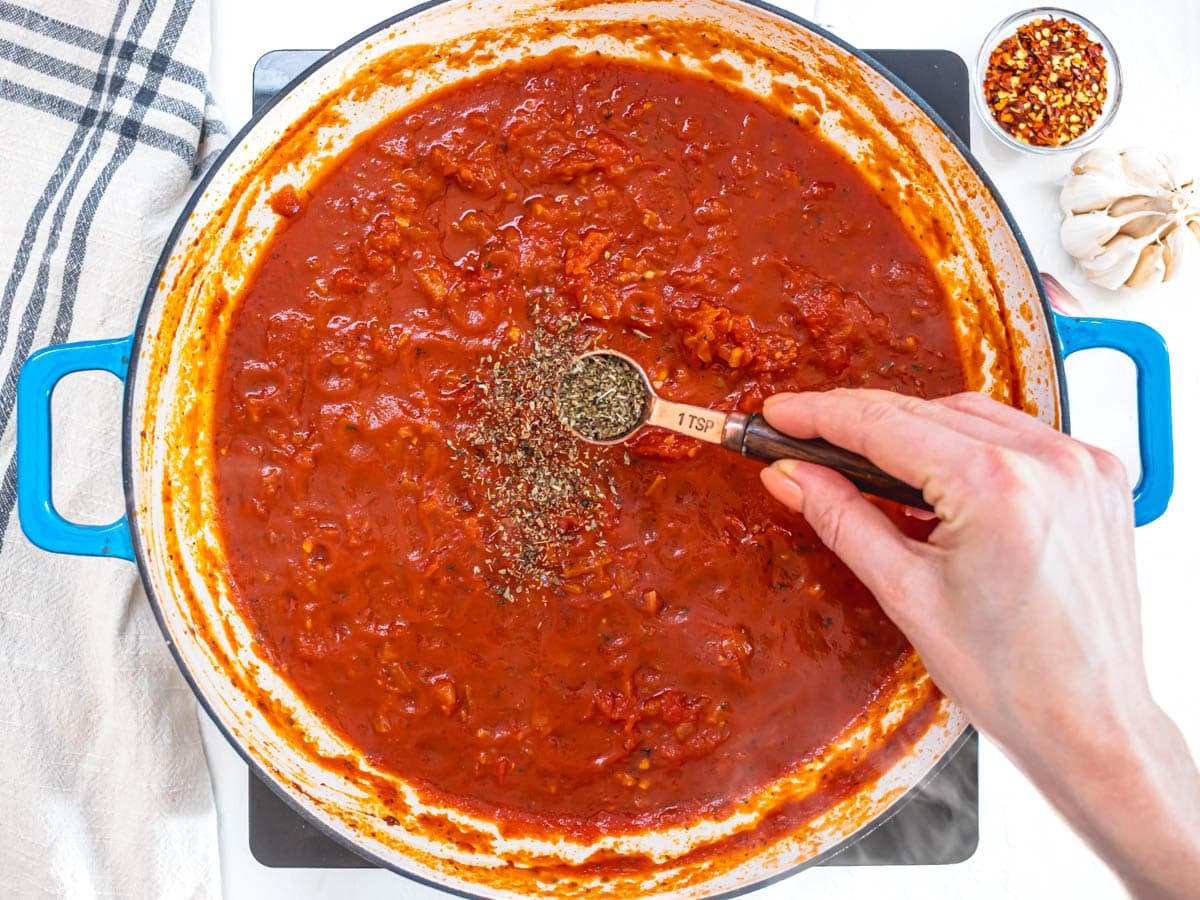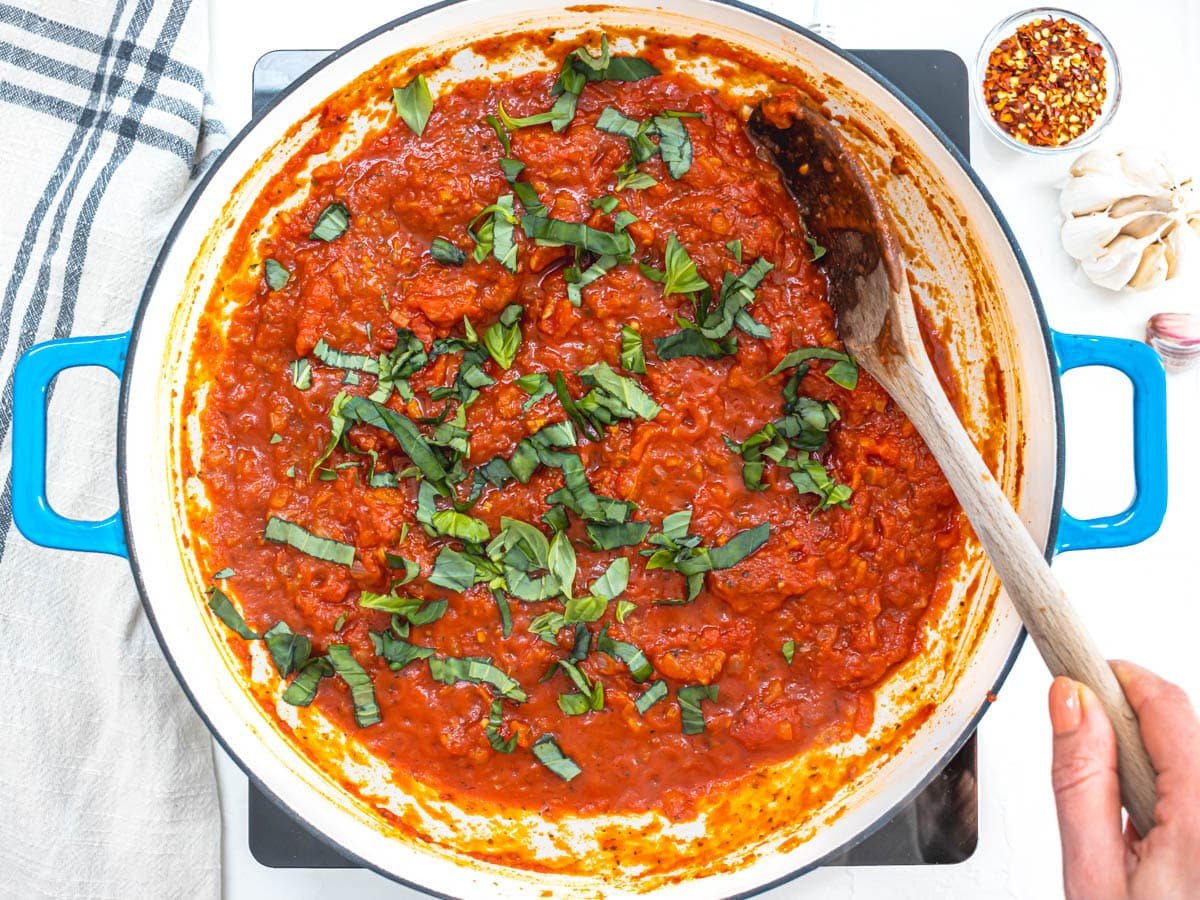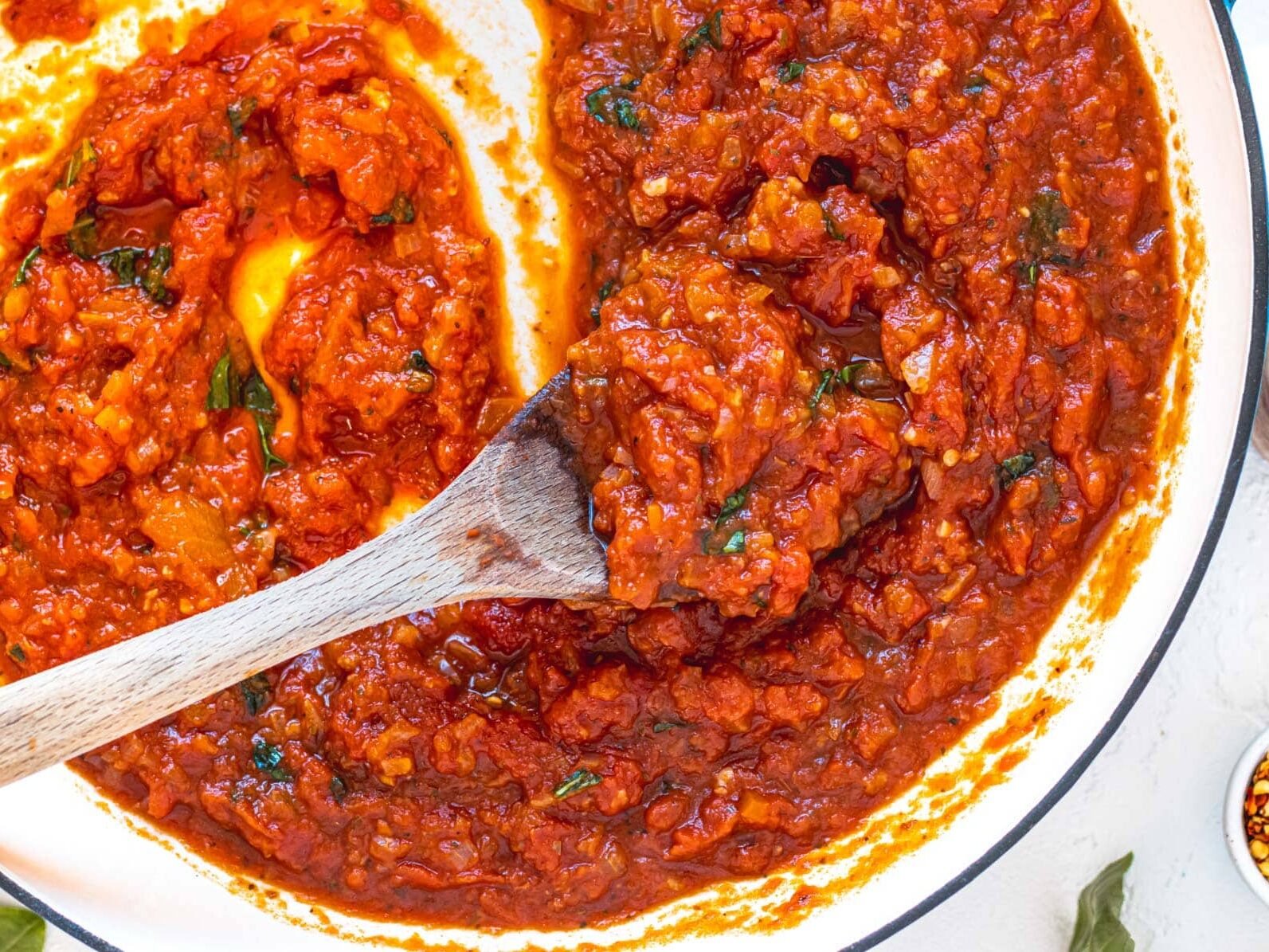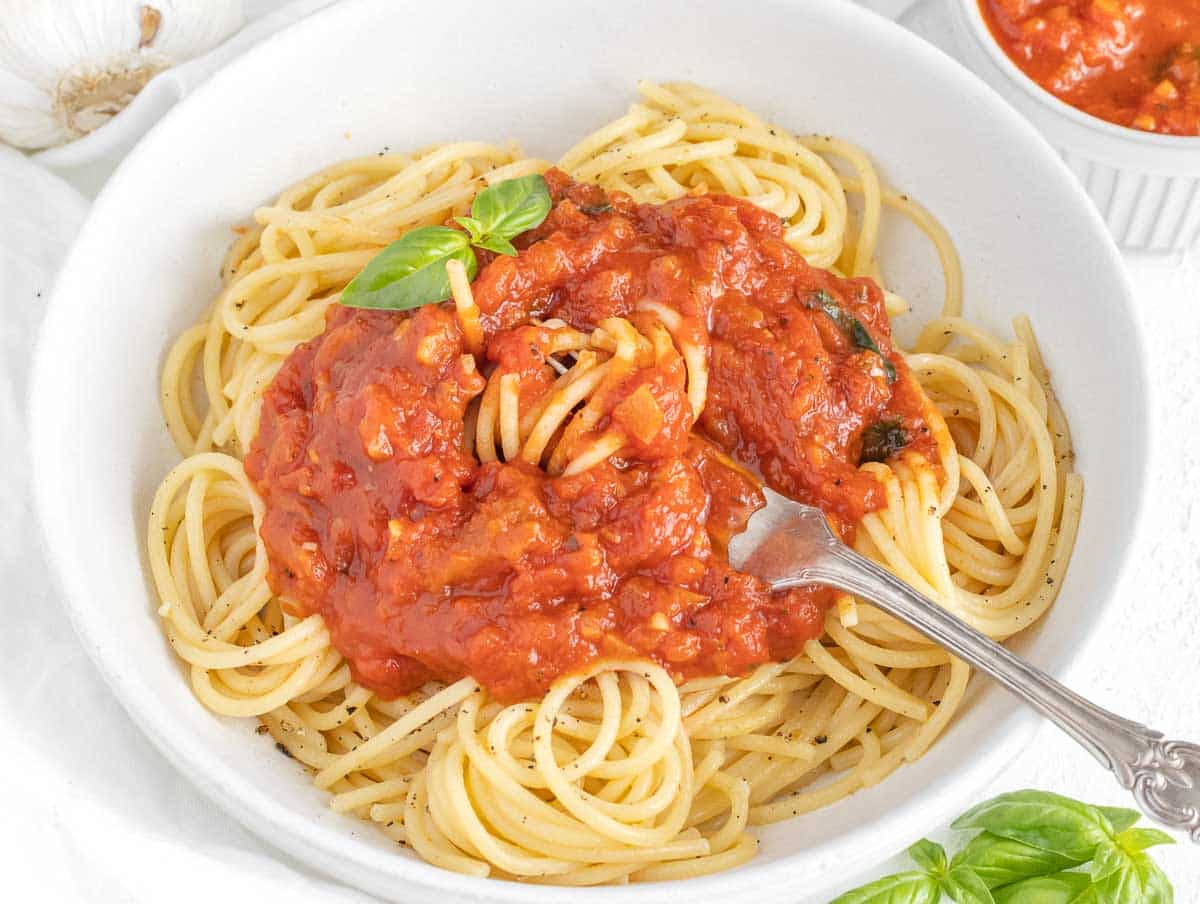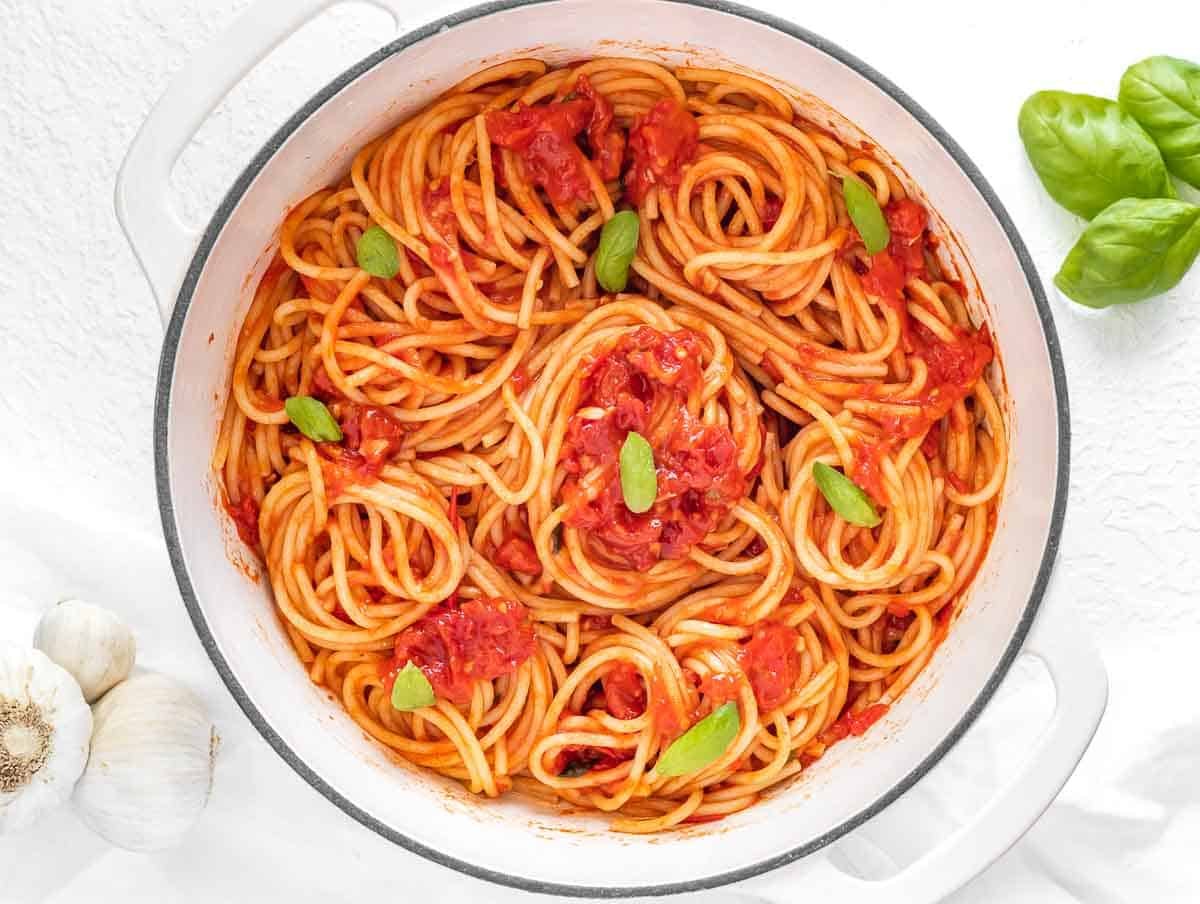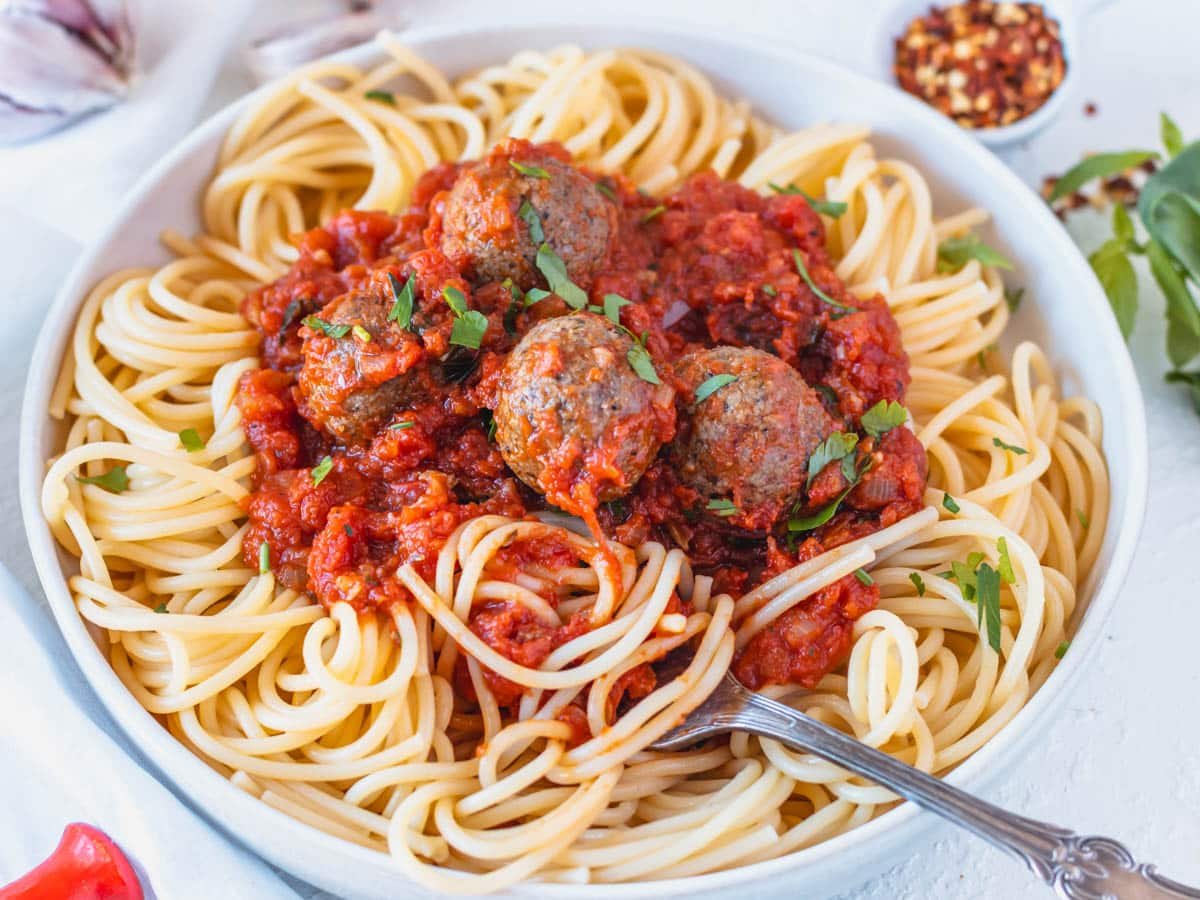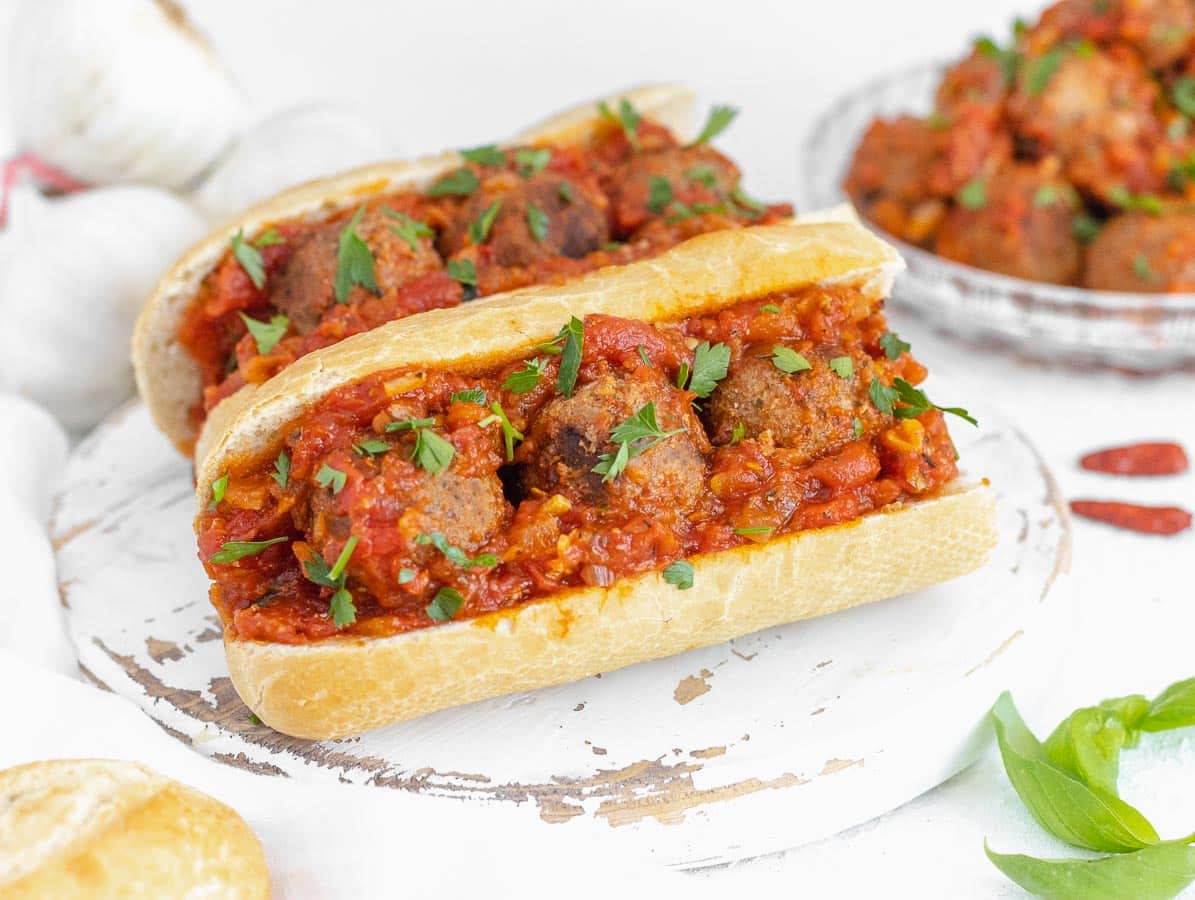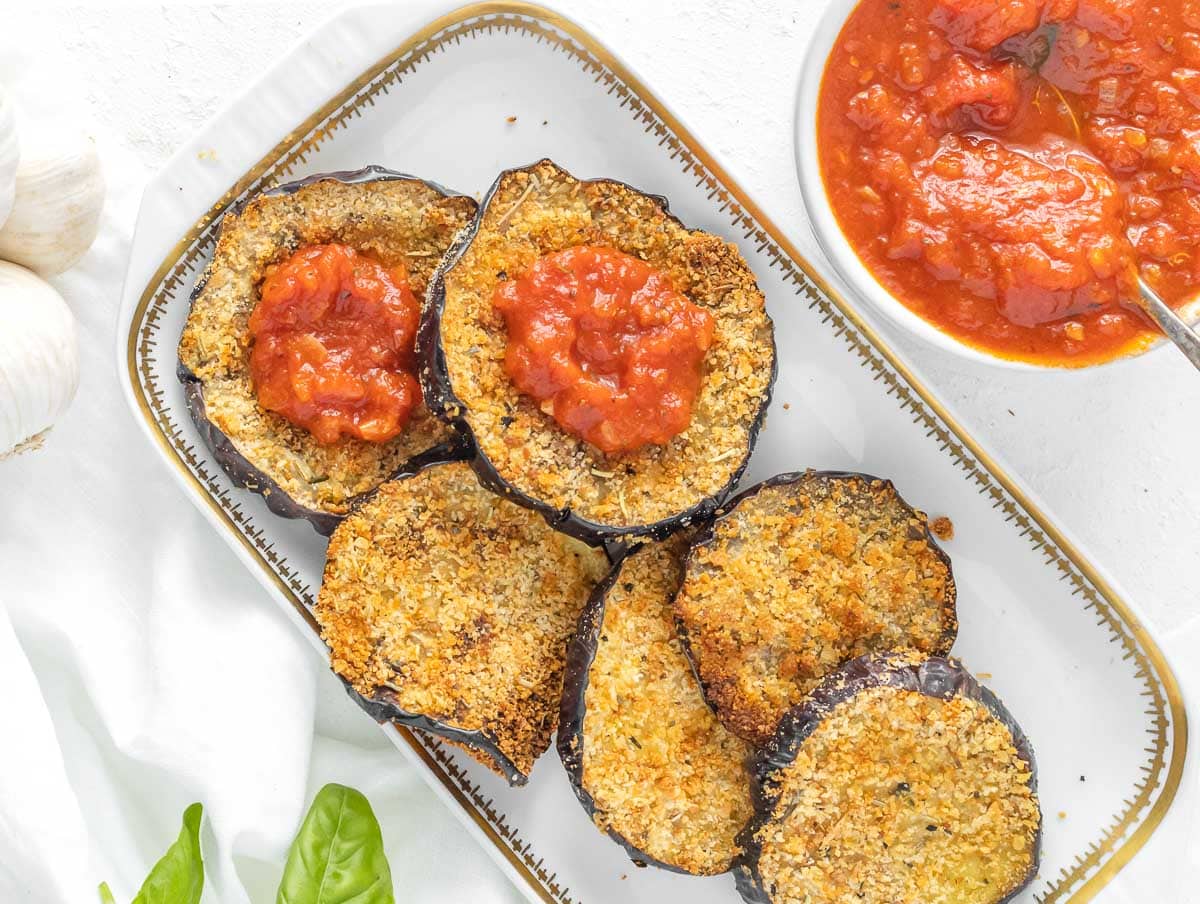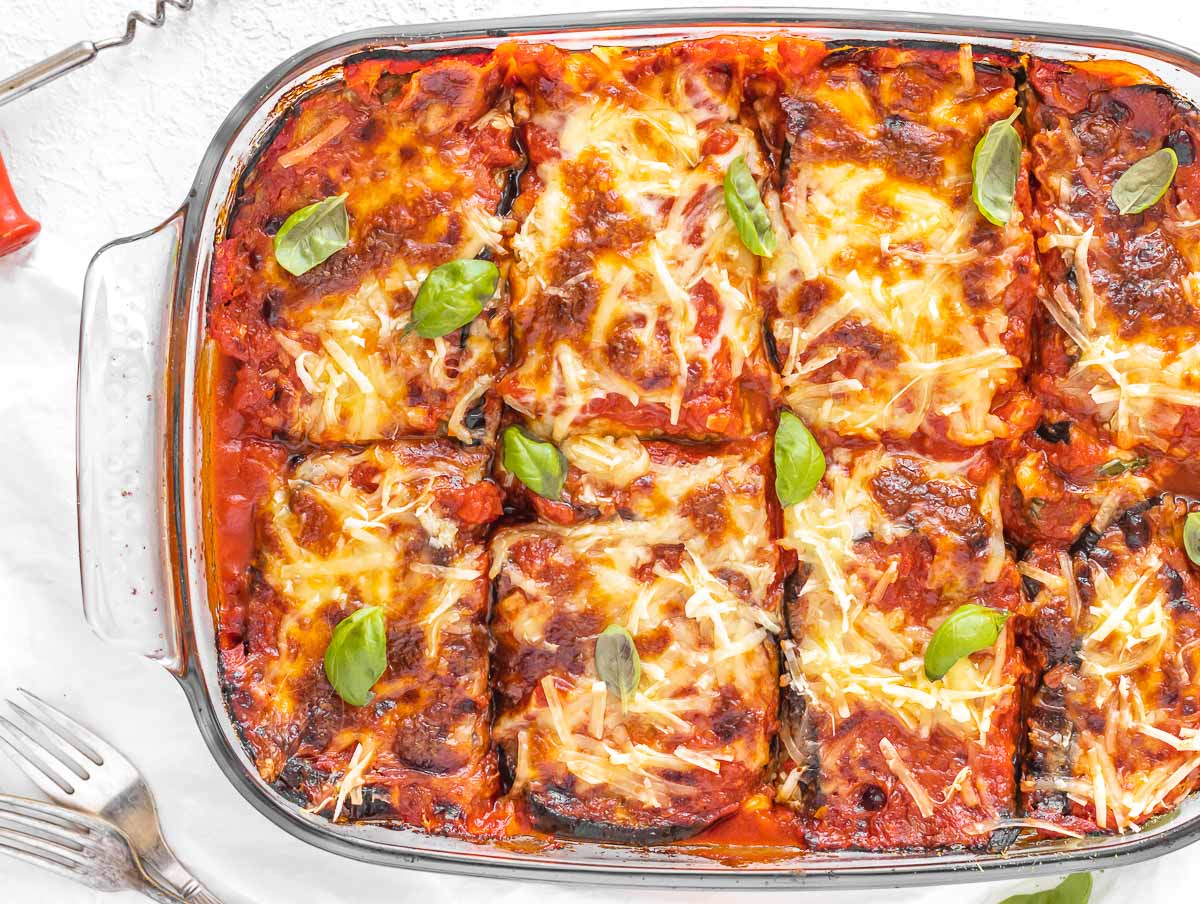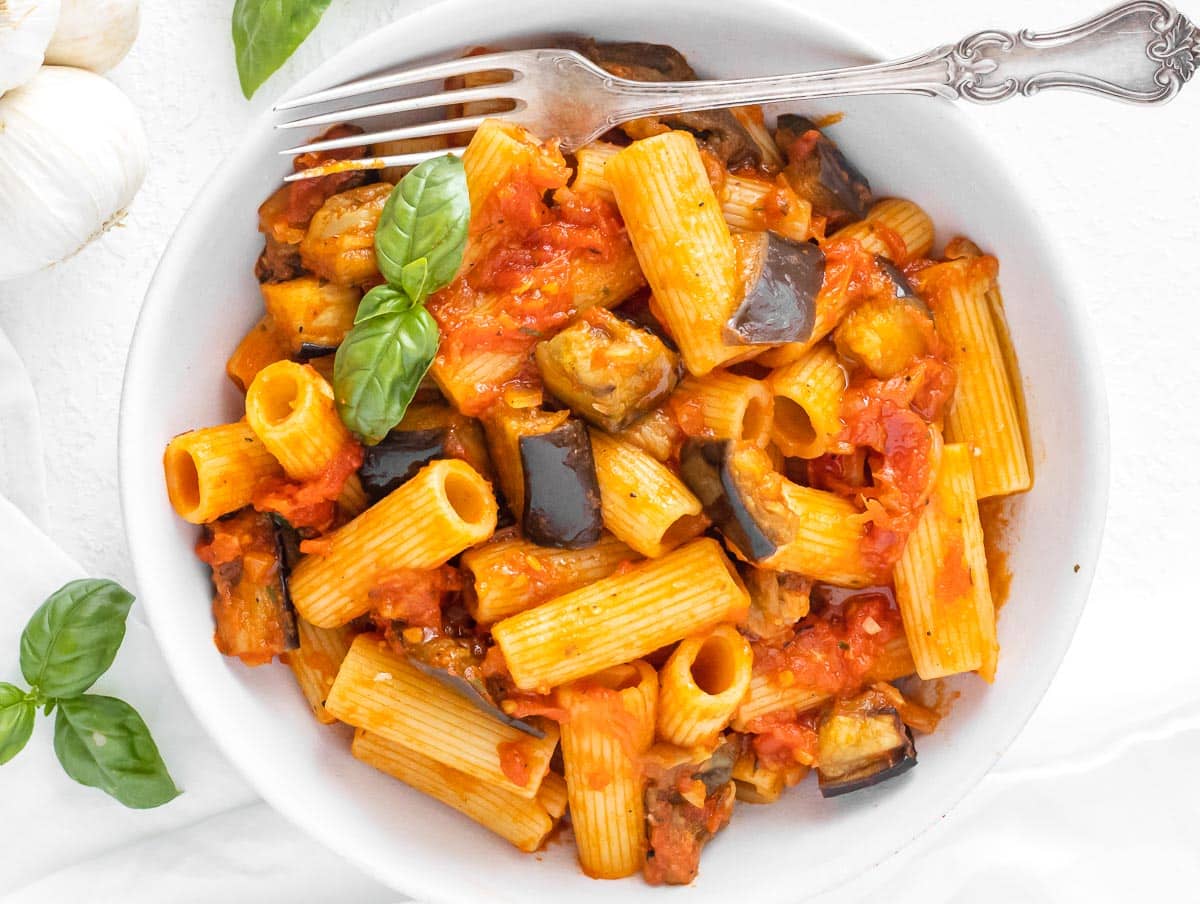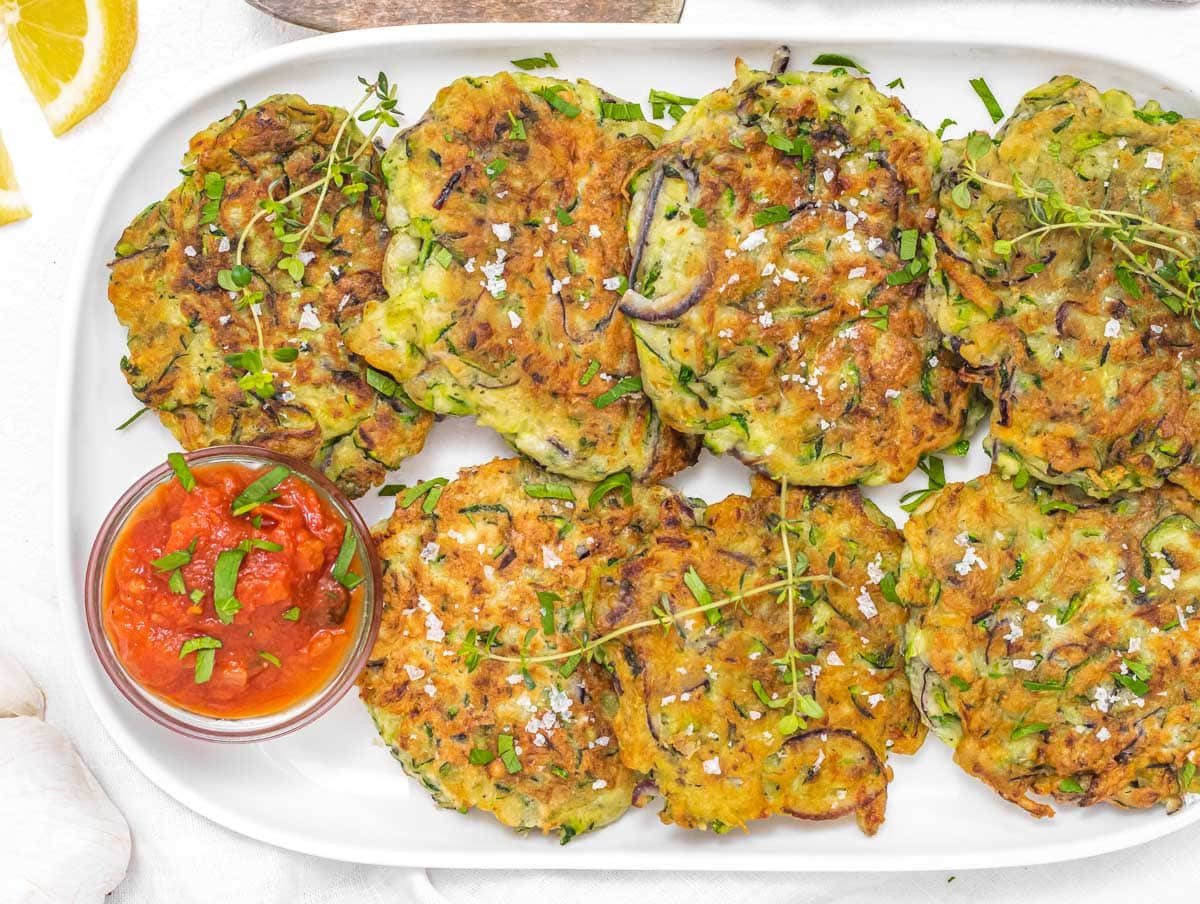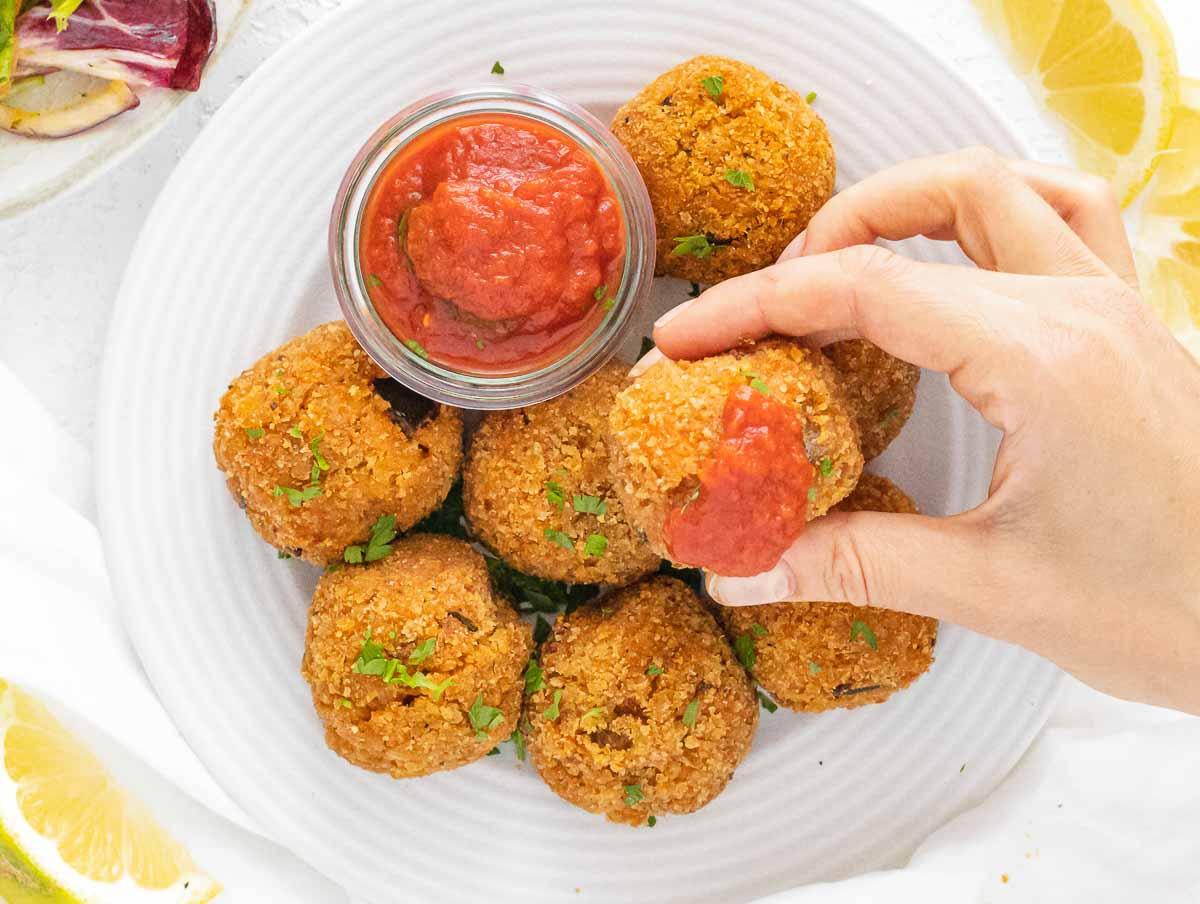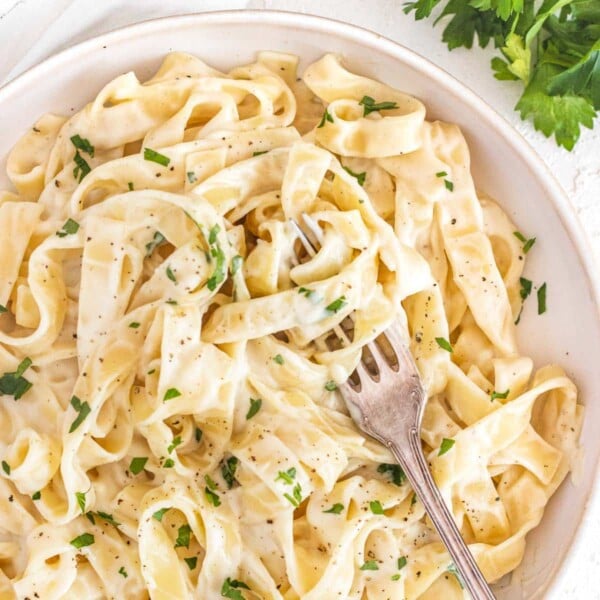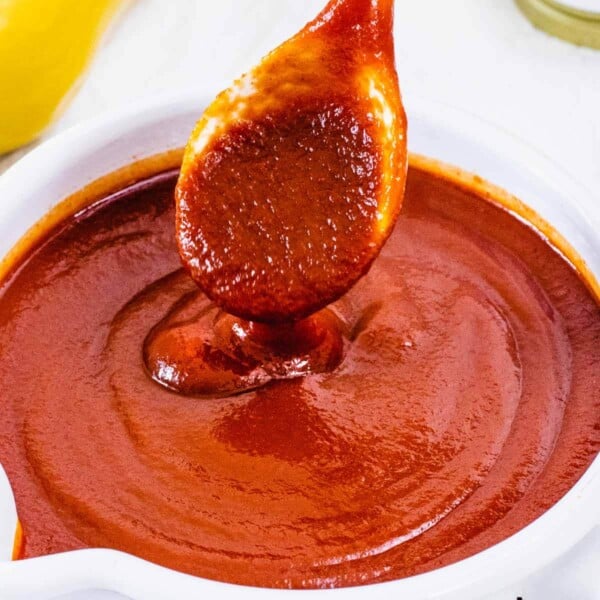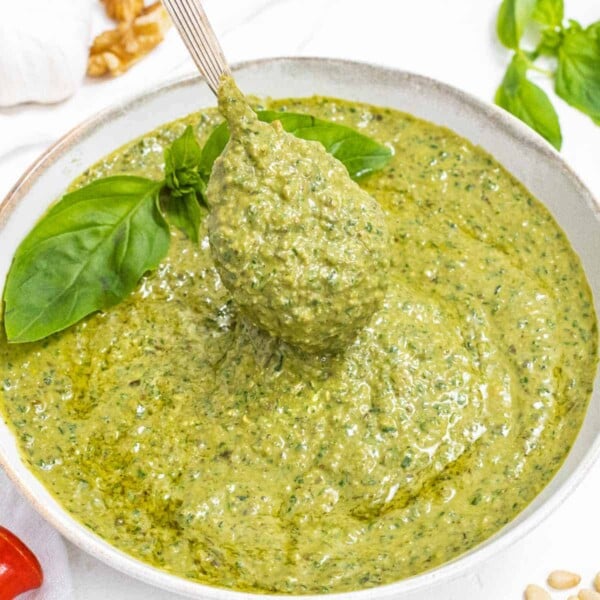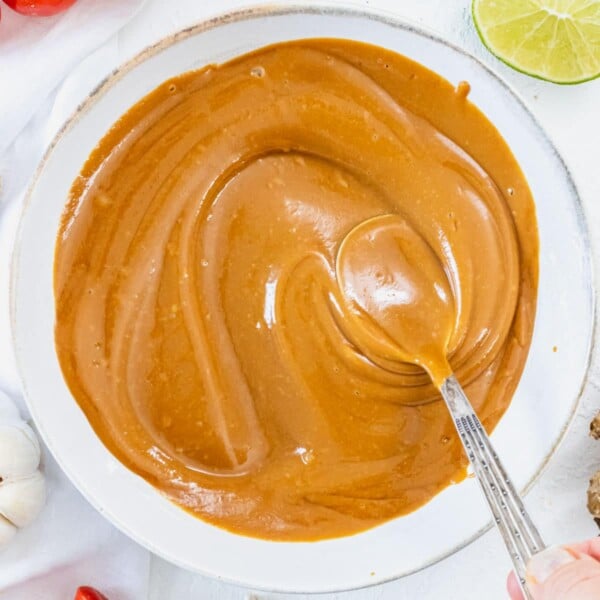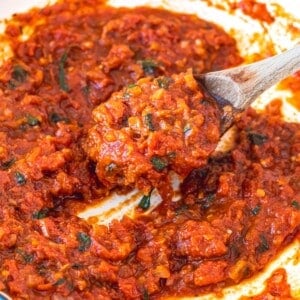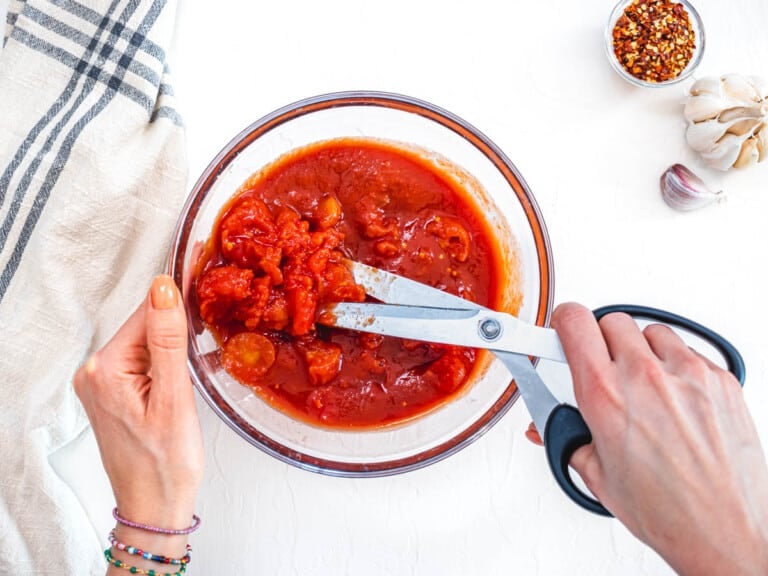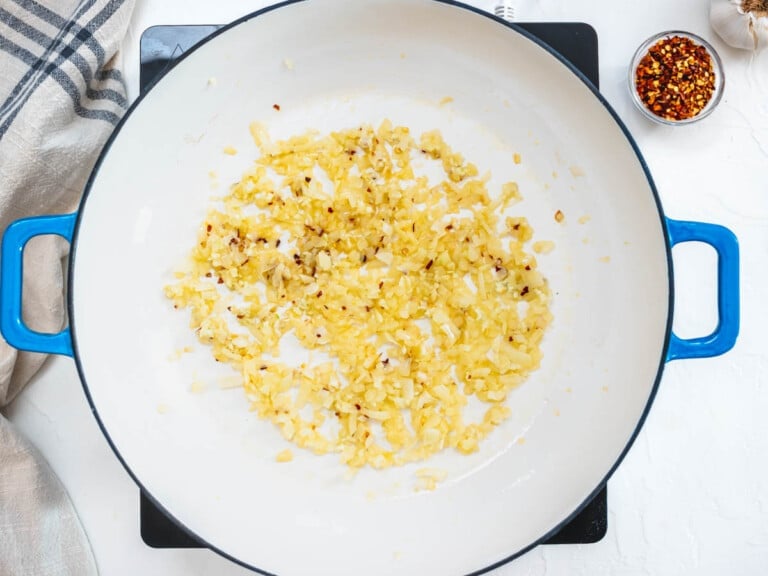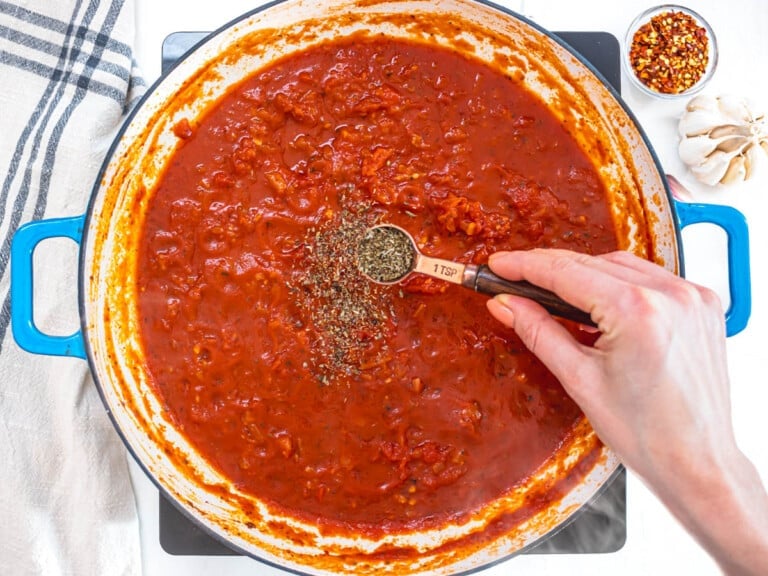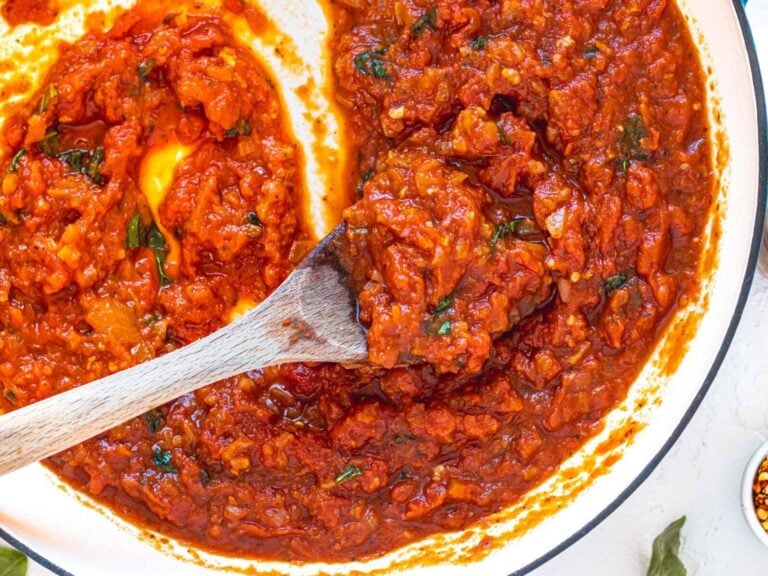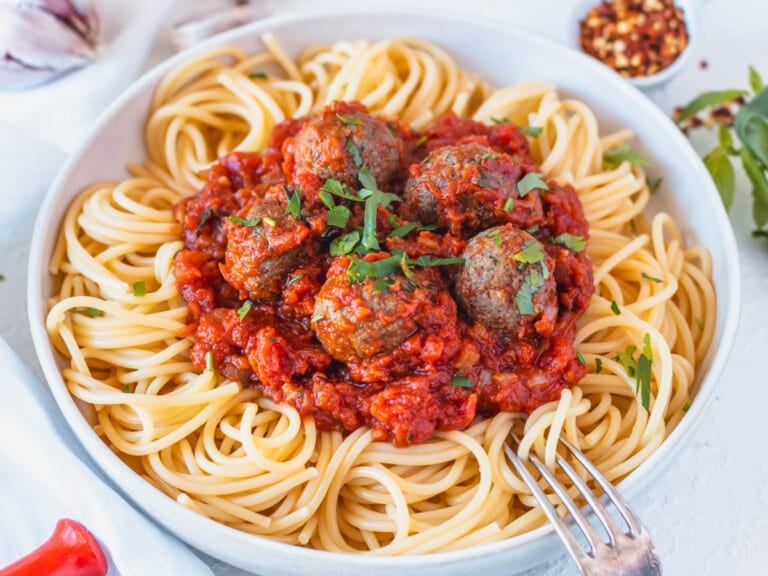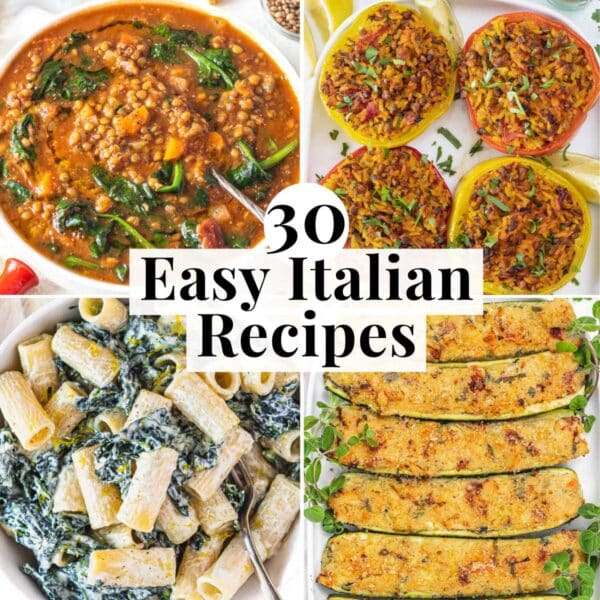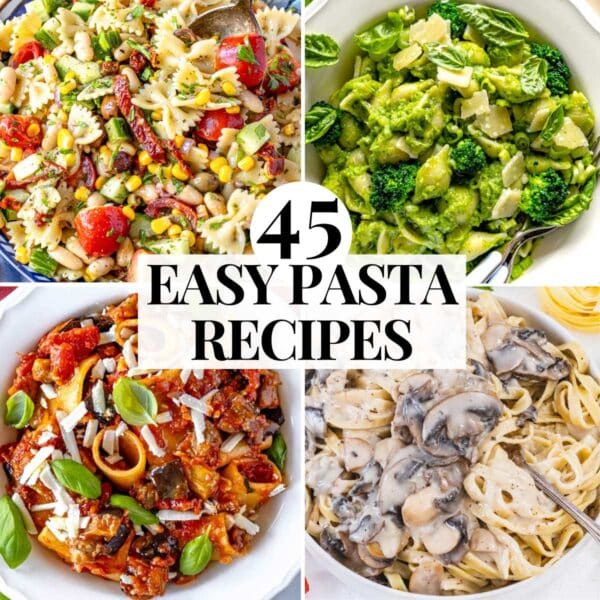You can make authentic Italian marinara sauce with simple ingredients like canned tomatoes, onion, garlic, herbs, and olive oil in less than 30 minutes. Dietary Note: this recipe is suitable for a vegetarian, vegan, and gluten-free diet.Don’t have time to read the full blog post? JUMP TO RECIPE HERE!
What is marinara sauce?
Marinara sauce video
Ingredients & Substitutions for Marinara Sauce
How to Make Marinara Sauce
Serving Suggestions
Breaded Eggplants
As a dip
Make Ahead & Storage
More Italian Recipes
More Sauce Recipes
With cherry tomato pasta, mushroom Alfredo, orecchiette with sausage and broccoli rabe, and creamy broccoli pasta, spaghetti with marinara sauce is a ultra comforting 30-minute weeknight Italian dishes that everyone loves.You’ll love how easy and versatile this marinara sauce recipe is. You can make it with a handful of pantry staples and have it in a million different ways. For example, try it with our tofu meatballs on pasta or in a sub. You’ll be blown away by how delicious vegan meatballs can be! Or use it for eggplant parmigiana, eggplant pizza, or Sicilian pasta alla Norma. Buonissima! It’s excellent as a pizza sauce on our easy flatbread pizza recipe and even better as a dip with fried zucchini, breaded eggplants, stuffed zucchini with ricotta, zucchini fritters, risotto cakes, rice balls, and fried eggplants. Best of all, you can use our marinara sauce as the base recipe for any tomato-based sauce. For example:
Add more chili and fresh parsley to make a spicy arrabbiata sauce for delicious rigatoni arrabbiata. Stir in olives and capers to make a tasty puttanesca sauce. A can of lentils to turn it into a quick version of our hearty lentil bolognese. A can of your favorite beans to make a fulfilling and nutritious Italian bean stew to serve with pasta or polenta. Mix it with sautéed mushrooms to have a quick, irresistible mushroom sauce.
The list could go on, but you get the point. This marinara recipe is the one sauce you’ve got to master to become a tomato sauce ninja!
Canned tomatoes
The best tomatoes to make the marinara sauce are Italian imported whole peeled tomatoes. If you can find San Marzano tomatoes, it’s even better. There are many brands of imported Italian tomatoes in the US and Western supermarkets; finding one won’t be a problem (Mutti, Cirio, and Cento are all great options). Other valid alternatives are diced tomatoes or crushed tomatoes. Still, in this case, we recommend adding a tablespoon of tomato paste to thicken the sauce and a teaspoon or two of sugar to balance the acidity.Tomato passata or tomato puree are not the best options because they are too smooth for marinara. Can you make marinara sauce with fresh tomatoes? You can make an excellent fresh tomato sauce that will taste amazing but different from marinara sauce.
Water
We use water to rinse the can of tomatoes and add it to the sauce. Nothing gets wasted in Italian home cooking.
Olive oil
Extra virgin olive oil is best. Its flavor enhances that of the tomatoes, garlic, and herbs.
Onion and Garlic
Fresh garlic cloves, finely chopped or minced. Garlic powder won’t add the same freshness and aroma. Onion is optional in marinara sauce, but we recommend it to add extra sweetness and flavor. There is no celery or carrots in marinara sauce.
Dried oregano
When you eat homemade marinara sauce, you should be able to taste the oregano. Marinara sauce originated in southern Italy, either around Naples or Sicily. In both those places, big bouquets or dried oregano are pantry staples used liberally in most recipes. If you don’t have dried oregano at home, a good alternative is dried thyme or Italian seasoning as a last resort.
Fresh basil
Fresh basil is optional and most probably a modern addition to the sauce, but we love it! The original recipe was invented by Italian Sailors – “marinai” in Italian – hence the name marinara. Being at sea for many days, they only had dried herbs on board, so it’s unlikely they could add fresh basil. However, we recommend adding a few basil leaves as they infuse even more aroma to the sauce and are an integral part of modern Italian home cooking. We don’t recommend other fresh herbs for this recipe.
Salt and pepper
Tomato sauce needs sea salt and freshly ground black pepper.
Red pepper flakes
We like adding a pinch of red pepper flakes or fresh red chili pepper to the sauce. Don’t add too much chili; you’ll turn marinara into an arrabbiata sauce, another delicious and spicy Italian tomato sauce. Start by finely chopping the onion and mincing the garlic. Add the whole canned peeled tomatoes to a mixing bowl. Rinse the can with 1 cup of water and add that too. Chop the peeled tomatoes with scissors, crush them with your hands, or blend them with an immersion blender. Heat the extra virgin olive oil in a large skillet. Add the chopped onion and sauté for 4 minutes on medium heat until translucent. Stir often, and don’t let the onion brown. Add the minced garlic and red pepper flakes (or finely chopped red chili), and sauté until fragrant for about 1 minute. Tip: use a large skillet instead of a narrow pot. The sauce will cook faster, splash less, and build more flavor in a wide skillet. Add the chopped canned whole peeled tomatoes. Season with salt, pepper, and dried oregano. Simmer on medium heat for 15 to 20 minutes or until you reach your desired consistency. The longer you let it simmer, the thicker and richer the sauce gets. Stir occasionally. Tip: if you serve it with pasta, you can cook it while the sauce simmer. A minute before turning the heat off, stir in chopped fresh basil. Taste and adjust for salt, and your marinara sauce is ready. This is a great way to use it as a quick spaghetti sauce. You can add grated parmesan or our non-dairy parmesan on top. You can use marinara sauce with any pasta, including spaghetti, ziti, rotini, fusilli, penne, rigatoni, gluten-free pasta, and even zucchini noodles. The second way is to drain the pasta very al dente, then finish cooking it in the pan with the marinara sauce for another minute, adding a ladleful of reserved pasta cooking water to make it creamy.
Plant-Based Meatballs
With our tofu meatballs, you can have delicious plant-based meatballs that you can make with simple ingredients in less than 30 minutes. They are the perfect protein addition to marinara sauce. Check out our tofu meatball recipe.
Meatballs Sub
This meatball sandwich is perfect for a quick lunch, and you can make it with our tofu meatballs and marinara sauce. Make this with a freshly baked baguette (the one you can get frozen and bake at home). It’s the perfect lunch! You can drizzle the sauce on top of the eggplants and even serve the eggplants on top of pasta to make this a complete meal. Check out our breaded eggplant recipe.
Eggplant Parmigiana
Use this sauce to make our delicious eggplant parmigiana. We use oven-baked eggplants instead of fried ones, so the recipe is lighter yet delicious. Parmigiana is a classic eggplant Italian recipe served as a starter, main, or side dish. It’s a sure crowd-pleaser; we are sure you’ll love it, too. Check out our eggplant parmigiana recipe.
Sicilian Pasta alla Norma
Pasta alla Norma is an easy and flavorful eggplant pasta dish from Sicily and is a must-try for pasta lovers. You can make it with roasted or air-fried eggplant cubes coated in a marinara sauce. Check out our pasta alla Norma recipe.
Zucchini fritters Stuffed zucchini with ricotta and sundried tomatoes Risotto cakes made with leftovers from our tomato risotto or mushroom risotto Fried rice balls Fried eggplant Fried zucchini Crunchy crostini
Other Uses of Marinara Sauce
You can level up your meals in many ways with a good marinara sauce! You can also use marinara as a base sauce for other delightful recipes:
To make a vegetarian lasagna paired with our roasted vegetables and vegan white sauce. As a pizza sauce for homemade mini pizzas, focaccia, eggplant pizza, or flatbread pizza. To make a zucchini sauce for pasta, add air-fried zucchini or roasted zucchini. Instead of pizzaiola sauce for this delicious pan-fried tofu with tomato sauce.
Refrigerator: store in a bowl, covered with plastic wrap, or in an airtight container in the fridge for 4 days. Freezer: marinara freezes well. Let the sauce cool down completely, transfer it to a freezer-friendly container (we use a small mason jar), and freeze for up to 3 months. Thaw in the fridge or the microwave. Reheat: warm the sauce on the stovetop or in the microwave. We recommend adding fresh basil as you reheat the sauce.
Baked Ziti Pasta al limone Cauliflower Alfredo sauce with tagliatelle Mushroom Ragu Gnocchi alla Sorrentina Roasted red pepper pasta No-Knead Focaccia with rosemary
For more ideas, look at our 40+ Italian vegetarian dishes roundup.
Focaccia
Cauliflower Alfredo Sauce
Red Pepper Pasta
Gnocchi alla Sorrentina
Basil pesto Arugula pesto Sun-dried tomato pesto Romesco sauce BBQ sauce Tahini sauce Mushroom gravy Peanut sauce Vegan ranch dressing Tzatziki sauce
Or try any of these 25 top sauce recipes; they’re perfect for salads, pasta, and veggies. For more condiment ideas, check out our dressing and sauces category page.
BBQ Sauce
Vegan Pesto
Tzatziki
Peanut Sauce Recipe
45 Easy Vegetarian Dinner Recipes
30 Easy Italian Recipes
45 Easy Pasta Recipes
Meatless Monday Recipes
